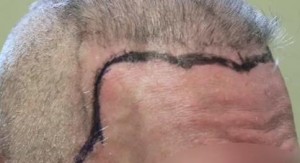One such example is the robotic Artas hair transplant system which has been designed for two main objectives:
1) Selection of follicles
2) Scoring of follicular units
Mechanical Elements of Artas Hair Transplant
The Artas system is mainly characterized by the following mechanical elements:
1) Digital imaging system that uses algorithms to identify follicular units and pinpoint the best ones through mapping and tracking technology. It is programmed to identify properties like:
- Angle
- Orientation
- Distribution
- Direction
- Density
2) Robotic arm of the Artas hair transplant system processes the information of the digital imaging system to perform the extractions using a 2 needle system
i. inner sharp needle to score the skin
ii. outer blunt dissection punch to execute a deeper punch and excise the hair graft.
How the Artas Procedure is Performed in A Hair Transplant Procedure
The patient is seated with their face down on a supporting structure. After the donor area is anesthetized, a skin tensioner is placed on the surface to gather information about the location of follicular units and decides which ones to score.
The robotic arm performs the extractions and uses light suctioning to elevate each hair graft from the surface. Forceps are then used to remove the grafts.
The surgeon reinserts the grafts into the donor area for hair replacement and restoration.
Is Artas FUE Technology The Best Choice For Hair Transplant?
The Artas system is considered to be physician controlled and robot assisted. However the process of choosing the best follicular units for grafting cannot be defined exclusively by algorithms and a five criteria system. Choosing hair grafts requires having a vision for a specific hairline and various nuances that are needed to achieve the best looking results for the patient.
Artas technology for hair transplant purposes is also limited by the obvious:
- Patients with dark brown or black hair
- Patients with straight hair
- Only hair on the back or sides of the head can be extracted. It therefore cannot be used for nape, beard or body hair. These types of extractions represent one of the latest advancements in FUE technique not available by Artas which has shown excellent results among patients who require an expanded donor supply.
Although engineers have managed to improve transection rates, there is still substantial risk of the grafts being buried and forming cysts.
With robotic and digital imaging technology, the Artas system may seem very cutting edge and impressive. However upon further inspection, it still requires additional refinements and development before it can be considered as the best choice for hair transplant.

